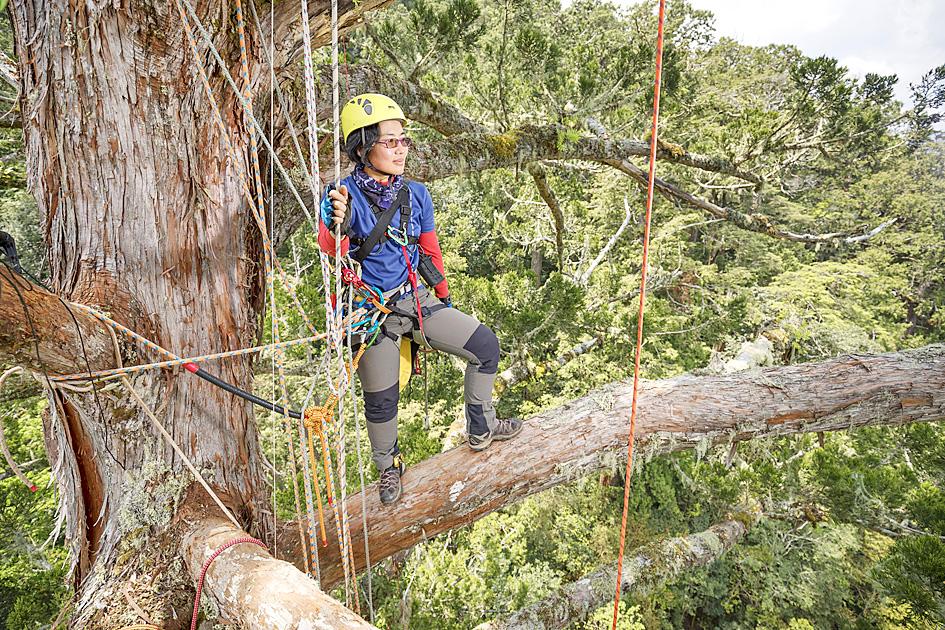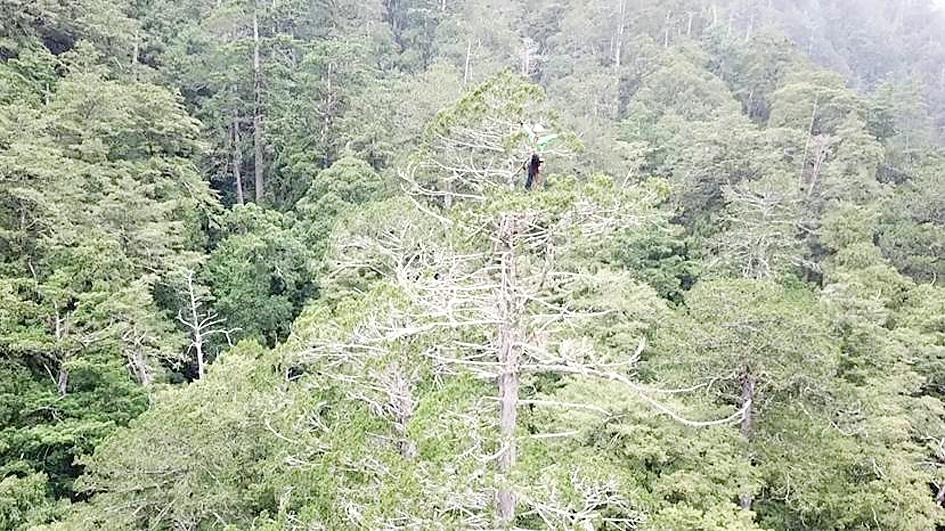The Council of Agriculture’s Forestry Research Institute has invited the public to participate in a project to map the nation’s remaining “giant trees.”
A researcher has challenged people to find a tree taller than the current record holder, which is a 79.1m Taiwanese cypress in the mountains of Hsinchu County.
The program, called “Tree Finder,” is a collaboration between the institute and National Cheng Kung University to locate Taiwan’s tallest trees by using lidar technology, institute researcher Hsu Chia-chun (徐嘉君) said on Jan. 2.

Photo courtesy of the Council of Agriculture Forestry Research Institute
“We have lidar scanning equipment on aircraft used in flights over Taiwan’s mountainous regions, as well as used to calibrate the collected data on tree measurements. This has enabled us to identify 272 trees that are more than 65 meters tall, the tallest of which is 79.1 meters,” Hsu said.
The tree, dubbed the “Taoshan sacred tree” (桃山神木), is of the indigenous Taiwania cryptomerioides cypress species.
“Each preliminary ‘giant tree’ measurement requires thousands of 3D point-cloud data points from lidar, but it still has an error range of about 10 meters. So field work is needed by our teams to locate the tree and take measurements on site,” she added.

Photo courtesy of the Council of Agriculture Forestry Research Institute
“It is really hard work, as most of these [trees] are located in remote areas, and it would take [teams] more than 10 days to just cut the undergrowth to make a trail to reach them,” she said.
Taiwan’s development began relatively late, so it still has well-preserved primary forest stands, Hu said.
This, combined with the nation being in a subtropical zone with high biodiversity, “has enabled Taiwan to become the only country in East Asia that still has giant trees in its mountains,” she said.

Photo courtesy of the Council of Agriculture Forestry Research Institute
“Only a few places in the world have forest stands of more than 70 meters. Taiwan is one of these few places and the only one in East Asia,” she said.
Taiwan’s forestry protection has been praised by many foreign scientists, Hsu said.
“They have said that Taiwan’s forests are among the best-protected in the world,” as it is rare for highly developed countries to retain their native old-growth forests, and some experts have touted Taiwan as the “New Zealand of the tropics,” she said.
Hsu said she cannot be certain which tree would be the tallest one.
“Nature is always unpredictable,” she said, adding that she wants to find out if Taiwan has trees taller than 80m, “but cannot be sure about it, as the Taoshan sacred tree could turn out to be the nation’s tallest.”
Her team used forest growth models and applied calculations to identify likely giant trees.
They then removed those located on mountain slopes of more than 70 degrees to come up with 54,415 images that are likely to contain giant trees, she said.
The images would be uploaded to www.no1tree.tw for the public to participate in the program.
“Each image needs to be verified by three people who would visually check the likelihood of trees of more than 65 meters,” Hsu said.
If a candidate is found, forestry teams would take an on-site measurement to verify it as a giant tree, she said.
“We will need at least 150,000 people to join the effort,” Hsu added.
She invited people to register on the Web site to help map the distribution of giant trees and “establish the tallest tree in Taiwan.”

An essay competition jointly organized by a local writing society and a publisher affiliated with the Chinese Communist Party (CCP) might have contravened the Act Governing Relations Between the People of the Taiwan Area and the Mainland Area (臺灣地區與大陸地區人民關係條例), the Mainland Affairs Council (MAC) said on Thursday. “In this case, the partner organization is clearly an agency under the CCP’s Fujian Provincial Committee,” MAC Deputy Minister and spokesperson Liang Wen-chieh (梁文傑) said at a news briefing in Taipei. “It also involves bringing Taiwanese students to China with all-expenses-paid arrangements to attend award ceremonies and camps,” Liang said. Those two “characteristics” are typically sufficient

A magnitude 5.9 earthquake that struck about 33km off the coast of Hualien City was the "main shock" in a series of quakes in the area, with aftershocks expected over the next three days, the Central Weather Administration (CWA) said yesterday. Prior to the magnitude 5.9 quake shaking most of Taiwan at 6:53pm yesterday, six other earthquakes stronger than a magnitude of 4, starting with a magnitude 5.5 quake at 6:09pm, occurred in the area. CWA Seismological Center Director Wu Chien-fu (吳健富) confirmed that the quakes were all part of the same series and that the magnitude 5.5 temblor was

The brilliant blue waters, thick foliage and bucolic atmosphere on this seemingly idyllic archipelago deep in the Pacific Ocean belie the key role it now plays in a titanic geopolitical struggle. Palau is again on the front line as China, and the US and its allies prepare their forces in an intensifying contest for control over the Asia-Pacific region. The democratic nation of just 17,000 people hosts US-controlled airstrips and soon-to-be-completed radar installations that the US military describes as “critical” to monitoring vast swathes of water and airspace. It is also a key piece of the second island chain, a string of

The Central Weather Administration has issued a heat alert for southeastern Taiwan, warning of temperatures as high as 36°C today, while alerting some coastal areas of strong winds later in the day. Kaohsiung’s Neimen District (內門) and Pingtung County’s Neipu Township (內埔) are under an orange heat alert, which warns of temperatures as high as 36°C for three consecutive days, the CWA said, citing southwest winds. The heat would also extend to Tainan’s Nansi (楠西) and Yujing (玉井) districts, as well as Pingtung’s Gaoshu (高樹), Yanpu (鹽埔) and Majia (瑪家) townships, it said, forecasting highs of up to 36°C in those areas